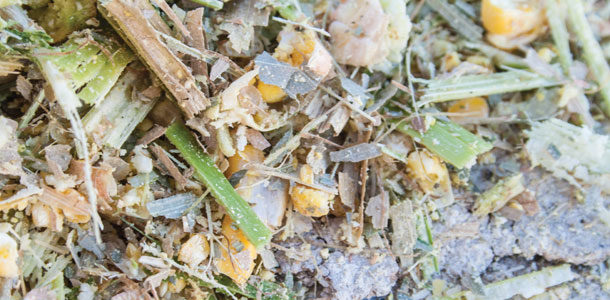After examining more than 90 peer-reviewed papers on the cost implications mycotoxins can have at a similar risk level, it was calculated that cows may produce 2.1 litres (4.8 pounds) per milk per day less when consuming mycotoxins.
Additionally, milk somatic cell count (SCC) was shown to increase by 157 percent. With this loss of performance, the reduction in profitability per cow is an estimated decrease of $1.11 per day.
Deductions in milk yield and rising SCC numbers may not be observable on a daily basis, but producers will notice the difference in production at the milk tank.
Many times it is not an acute case that can be readily identified but a chronic situation associated with the ingestion of a low level of mycotoxins over an extended period of time.
This results in a wide array of subclinical symptoms that slowly reduce performance, eat away at the producer’s bottom line and compromise animal health.
The mycotoxin survey sets the baseline for forage quality when producers start feeding the 2014 crop. The crop condition at harvest and the storage environment (temperature, oxygen, moisture) will determine if these levels rise during storage and increase the risk to cows.
Over the past two years, stored forages have increased in risk over the feeding year, and this risk needs to be monitored.
According to Anita Heeg, dairy specialist, Alltech Ontario, feed storage on-farm is a key issue, as a well-packed and sealed silo can be the turning point in determining the fundamental quality of a producer’s forages.
“If forages are of poor quality, the total ration’s quality may be decreased, resulting in decreased milk production, poor immunity and health, and impaired reproduction,” Heeg says.
Silage and stored feed are perfect energy sources, so producers, nutritionists and veterinarians should be aware of storage molds, particularly the Penicillium species, because of their ability to impact rumen function.
Regular audits of forage storage systems can help to decrease these risks by assessing bunk density with a core sampler or heating in bunk faces or tower silos with an infrared (IR) camera.
Proper density in bunk silos ensures adequate fermentation by decreasing the presence of oxygen just as tower silos are sealed to provide an anaerobic environment.
Properly fermented feed is considered “pre-digested” by microbes in the silos in order to allow the cows easier access to the essential nutrients they need to support their health and production through gestation and lactation. When oxygen is allowed into a silo, mold growth can begin, and heating can be detected with an IR camera.
“If an IR camera is used and heat is detected, the producer can take steps to remove moldy feed as it comes out of the silo,” Heeg says. “By utilizing these tools, a producer can ensure that the farm’s forages are of high quality and maintain herd health.”
Heeg encourages producers to follow a checklist when reviewing their feed storage over winter.
“It is essential that producers stay on top of issues on their farm and deal with them before they cause damage to their bottom line,” Heeg says. “Early detection and subsequent prevention are key to getting the most out of your feed and maximizing your herd health and performance.” PD
Photo by PD staff.

- Max Hawkins
- Nutritionist
- Alltech Inc.
Checklist of items to consider when storing feed
1. Check grain for mold growth regularly.
2. Patch any holes in bin, plastic covers, bags or wrapped bales as soon as possible.
3. Discard obviously spoiled feed or layers of feed.
4. Evenly cool grain in the bin during a mild winter. Coring takes one or more truckloads of corn from the bin and levels the crop that remains. This process removes the fine materials that settle in between and fill air pockets between kernels.
5. Clean out leftover feed from feeding bunks regularly.
6. Ensure sufficient and consistent air movement in the bin.
7. When confronted with a toxicity problem, stop feeding the contaminated feed.
8. In consultation with your veterinarian or nutritionist, consider the use of a mycotoxin adsorbent to be mixed with the feed. A modified yeast cell wall extract that is a natural fibre source can often be used at practical levels of inclusion.










